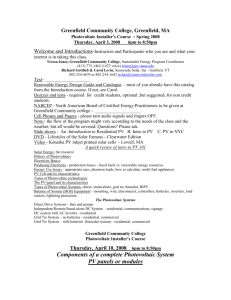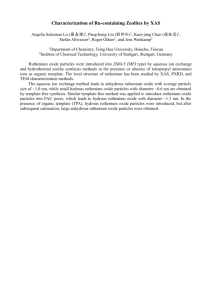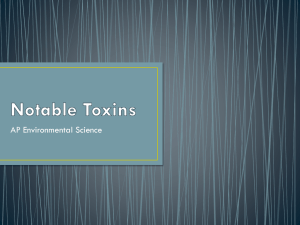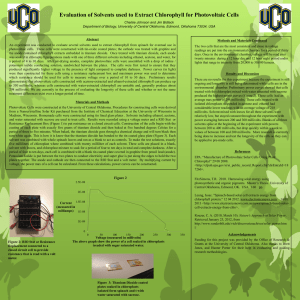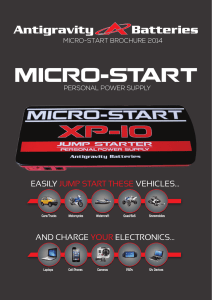max`s group - slider-chemistry-12
advertisement
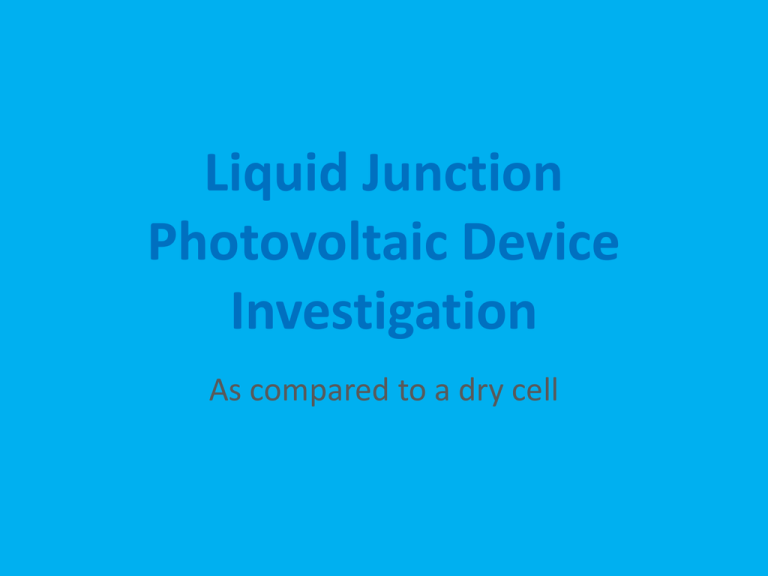
Liquid Junction Photovoltaic Device Investigation As compared to a dry cell What is it? • These solar cells have the ability to convert light energy from the sun into electrical energy • These solar cells are almost twice as efficient at converting light energy into electrical energy as those currently commercially available • Applications: provides power for homes and outback installations, lighthouses, pumping water and emergency telephones Chemistry Liquid Junction Photovoltaic Device Dry Cell Cost and Practicality Liquid Junction Photovoltaic Device Dry Cell • As a result in the different application of the cell, it is more expensive than a dry cell • In comparison to other photovoltaic devices, it is cheaper and easier to produce Advantages • More efficient and environmentally friendly way of obtaining electrical energy • Durable • The metal oxide that is used (titanium oxide) is easily obtainable • Relatively cheap Advantages • Readily available for purchase and use • Useful when small currents are needed (e.g. for a torch or toy helicopter) • Easy to store • Simple to use Disadvantages • Can be prone to leaking • Small current may be insufficient Impact on Society Liquid Junction Photovoltaic Device Dry Cell Society has been trying to harness the ability of converting sunlight into energy since the 1960s, this is because the reliance on fossil fuels is ineffective in an environmental and social sense. Therefore Photovoltaic cells present benefits for society. These societal benefits are that it gives a possible solution to finding a renewable energy source that can be commercialised on a large scale that fossil fuels and dry cell batteries have. If photovoltaic cells can be commercialised then it offers a solution to society to enable them to lower the necessity of fossil fuels and convert to renewable sources of fuel. However this would also have a detrimental effect on society, as the energy industry is very large meaning that those who do not have the capabilities or who have not been making steps into renewable energy will fall behind and fail as businesses, meaning that unemployment could increase in society. Dry cell batteries have a large impact on society, without us realising their importance. Dry cell batteries are used in many household appliances which we could not use without, such as a torch; portable light would not be readily available if dry cell batteries did not exist. The dependence on dry cell batteries comes from their portability, small size and they are very cheap and easy to create. However as these dry cell batteries have short shelf lives, meaning they do not last long, has a negative effect on society as it creates a lot of un-recyclable toxic waste as the zinc casing of the batteries react with the ammonium ions in the battery causing it to deteriorate and leak toxic substances which are harmful for animal life, this will be covered in depth in the environmental stage. Environmental Impact Liquid Junction Photovoltaic Device Dry Cell - The environmental impact of the Gratzel Cell is low, in fact beneficial as it uses a renewable source of energy and titanium dioxide is a mineral found in sand. Over 95% of all the solar cells produced worldwide are composed of the semiconductor material Silicon. As the second most abundant element in earth`s crust, silicon has the advantage, of being available in sufficient quantities, and additionally processing the material does not burden the environment. Though, the photovoltaic cells do not use silicon often, instead they use iodide, ruthenium coated with titanium oxide. - Ruthenium is one of the rarest metals on Earth. Ruthenium compounds are encountered relatively rarely by most people. All ruthenium compounds should be regarded as highly toxic and as carcinogenic. Iodide and titanium dioxide has no reported effects on the environment. - Dry cell batteries are household batteries used in power tools, watches, video cameras, calculators, hand-held vacuum cleaners, flashlights, toys, hearing aids, etc. They include alkaline, alkaline rechargeable, lead acid sealed, lithium, metal hydrate, mercuric oxide, nickel-cadmium, silver oxide, and zinc-air batteries. The environmental impact of mercury, silver, lithium, cadmium, lead and acid all have the potential to be hazardous waste. If the batteries are burned or land filled, the heavy metals in them can be released into the environment. These metals could pollute groundwater, surface water and the air when burned. Not to mention the risks to the people who work around these landfills.


